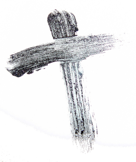 Considering Consecrated Life
Considering Consecrated Life
“Lenten Observance”
Two liturgical events during the Christian year stir me. Both transpire during the time of Lent and lead to my observations.
One takes place towards the end of this penitential season on Good Friday. The reverencing of the cross by the Christian community never ceases to inspire me. Everyone draws near. No barrier exists due to age or sin or separation from the Church. Some of the aged come and simply touch the wood because they cannot bend to venerate in any other way. Some individuals insist on kneeling and kissing the cross as low as they can; they kiss the feet of Jesus if it is a crucifix. A mother will approach with babe in arms and kiss the wood while the child looks on interested, then the mother whispers to the baby to kiss the cross and the child does so obligingly. This last illustration usually reminds me that our children are baptized into our faith.
The other event happens at the outset of Lent on Ash Wednesday, and involves, as you might imagine, the distribution of the ashes. Again, people come forward without any barrier of maturity or state of grace or alienation. One can receive these ashes at the Eucharist or at a separate service. Ministers go to hospitals, visit the shut-ins, and travel to varied institutions. People of all faith persuasions, and sometimes none, seek and receive the ashes. When I see small children receive the ashes, I would love to be able to hold up a mirror for them to see what they look like. The children must marvel about parents who would immediately wipe that off of them if they did it themselves with mashed potatoes. I consider if the ashes remind the aged in a particularly poignant way of how much closer they are to returning to that dust in this coming year. I have mused on that reality myself as the need for changing life and believing in the Gospel becomes more urgent.
This year on Ash Wednesday, I celebrated the 8:00 mass in St. Thomas More Church on the St. John’s University campus with confreres and members of the University community. After the blessing of the ashes, the ministers begin by marking one another. I hear: “Reform your life and believe in the Gospel.” As I sign the other confrere, I am tempted to say “You, too.” I would not intend that to be flippant, but a recognition that I heard what he said and that we celebrate this season together. We aid one another in celebrating Lent worthily.
After the distribution has taken place comes the moment when I am most captivated. While imposing the ashes on those who come forward, I focus on the tree but lose the forest. After we are finished and thumbs are reasonably cleansed, the opportunity to look out at the congregation arrives. Everyone in the Church bears the symbol of the cross clearly on his/her forehead! When else in our Christian celebrations is that so evident? When else does everyone receive the same mark? Whether someone believes deeply or is wrestling with their faith, they have chosen to accept this sign of our commonality. While the thought enriches, the sight moves the heart.
Throughout the course of the day, students and faculty and staff will wander the campus and others will see them. Some will think that they, too, need to receive the ashes and will make an effort to do so. This day demands many opportunities for receiving ashes. Young people, who still wonder about their faith and its place in their lives, will none the less recognize this sign for what it is: a summons to be better people. And they will respond.
Could it be that the ashes received on this special day of the liturgical year are not blown off by the wind, or rubbed away with unconscious swipes, or washed from the face as a normal part of cleanliness? Could it be that they are absorbed into our skin like ointment or chrism? The cinders serve to unite and heal as well as identify and remind.
The observance of this Lenten practice puts one in mind of John the Baptist, and in a particular way at St. John’s. We can hear his cry: “Prepare the way of the Lord.” For a consecrated person, this summons can have special meaning as interpreted in light of a unique charism. Whatever community to which we belong places upon us a need to live the Christian life faithfully. As vowed Vincentians, that involves the preaching of the Gospel to the poor. The ashes can help to reconfirm us in that commitment by reminding us of that which is most important as individuals and as Vincentian Family.







0 Comments